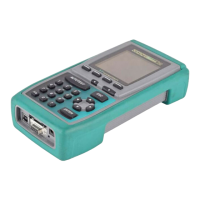OMNIScanner User Guide
4 - 6
If you cannot find or do not know the name of your cable manufacturer,
simply select a cable from the Generic folder, or create a new cable.
Press (Delete) to permanently remove a custom cable.
Note:
Default cables cannot be removed.
With a twisted pair or a coaxial cable highlighted, press (Edit)
to edit an existing custom cable. Cable Name, NVP, or Impedance can be
changed.
Note: Default cables cannot be edited.
With a twisted pair or coax cable highlighted,
press (New) to create a new cable based on
the NVP and Impedance values of the highlighted
cable. Name, NVP, and Impedance are definable.
Note: A new or edited cable will be saved in the
Custom Cables folder.
For an accurate Length test, the NVP (Nominal
Velocity of Propagation) must be set correctly. The
value is usually specified by the cable vendor, and
OMNI
Scanner
has a large library of cables with the
manufacturer’s specified NVP.
To determine the NVP of a cable with a known length, press
(Measure) to capture the length of the cable using the displayed NVP. Use
the ê to highlight the NVP: field and press ENTER. Use the é or ê arrow
key to increase or decrease the value by 1% (percent) and adjust the NVP
until the known length is displayed. The Length: changes accordingly.
Note: The known cable must have a length of at least 50 feet or 15 meters.
To change the Impedance; use the ê to highlight the field and press
ENTER. Use the é or ê arrow key to select the appropriate Impedance in
ΩΩ
ΩΩ
Ω (Ohms) from the predefined list.
To setup whether or not the cable is shielded, use the ê to highlight
Shield: and press ENTER. Use the é or ê arrow key to make the appro-
priate selection. If ‘Yes’ is selected, the wiring for the shield will be mea-
sured during the Autotest and used to determine if the Wiremap will PASS
or FAIL.

